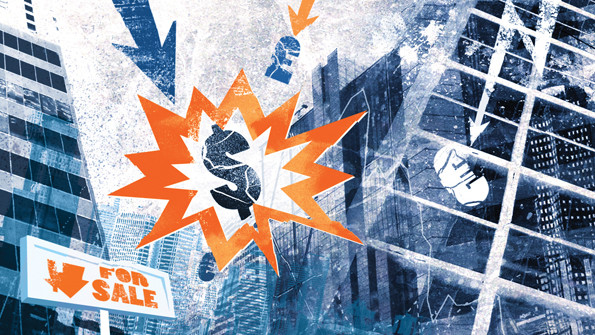
Ever been puzzled by what, exactly, happened in the 2008 economic crisis? Why the world economy is still reeling? And, most importantly, why it’s so difficult to find a summer job?
In this series, we’ll break down some of the key determining factors of the global economy—or, at least, try to.
The Lead – Up
From the late 1980s until the mid 2000s, the world economy experienced stable, but solid, economic growth with low inflation (meaning the value of money did not significantly decrease over time). This period was referred to as the Great Moderation. Sounds good, right? Not quite.
This economic confidence provided many American financial institutions with the capability and motivation to engage in risky behaviour. Mortgage brokers provided some home-loans to potential owners deemed “high risk”, people who were likely to default (not pay) the debt owed on their house. Mortgage brokers were tempted to hand out such loans because they had a lot of available money and, with risky clients (often-referred to as sub-prime borrowers), they could charge a high interest rate. The brokerage houses offered low “teaser” rates in the first few years of the mortgage, and then increased these rates to over 10 per cent in the later years.
Risky? Indeed it is. But many American financial institutions thought they could protect themselves against it, and they underestimated the risk.
Tasked with increasing home-ownership rates, the Federal National Mortgage Association (FNMA, nicknamed Fannie Mae) and the Federal Home Loan Mortgage Corporation (FHLMC, nicknamed Freddie Mac), bought these mortgages off of the lenders. With immediate cash from these sales, mortgage lenders had more money to provide more home-loans to more sub-prime borrowers.
Fannie Mae and Freddie Mac sold their purchased mortgages to investment banks, which pooled the default risk, combining chunks of thousands of mortgages into one thing: a Mortgage Backed Security (MBS). Instead of buying individual mortgage guarantees (buying a mortgage from a broker and receiving the homeowner’s payments), investors could buy a Mortgage Backed Security.
An MBS was less risky because a few homeowners defaulting on a loan would hardly detract from the value of it, considering there were many mortgages within the one security. There was also another risk: many individuals from a particular city defaulting on their mortgages. If, for any reason, housing prices dropped in one city, many citizens might be tempted to default because the amount owed on their mortgage might be worth more than their house. A little scary? MBS usage could, supposedly, protect against this. Since MBS were formed from mortgages across the United States, a housing market crash in one city would, likely, not pose a significant threat to an MBS.
To help safeguard MBS holders, insurance companies devise a specialized policy: credit default swaps, which would insure investors against any losses resulting from mortgage-defaults.
And, to add to investor confidence, credit rating agencies did not properly inform investors about the risks they were incurring.
Credit Rating Agencies—which held a conflict of interest, being paid by firms issuing MBS and not investors buying them—had an incentive to give overall positive credit ratings, so investors would continue to purchase them. Sometimes, these positive ratings were excessively optimistic, leaving investors over-confident about their mortgage-holders’ default risks.
The Crash
In 2006, the American housing market turned sour, with massive declines in home prices (and Economists are still not sure why). Many Americans decided they did not want to keep their houses, as the value on them was dropping (often times making it less valuable than the amount owed on their mortgage). At that point, it was easier for homeowners to default on their mortgages and lose their houses, than to keep paying their mortgage.
These defaults soon brought huge losses to the financial sector. In early 2008, the Countrywide Financial Corp, one of America’s biggest mortgage lenders, went bankrupt.
In March 2008, Bear Sterns, an investment group with many MBS in its portfolio, went bankrupt as well, and ended up being bought out by JPMorgan Chase ( at a fraction of the price JP Morgan might have paid in 2007).
These financial collapses also hit the insurance industry; American International Group, America’s biggest insurance company, went bankrupt, largely as a result of the huge losses they faced paying out credit default swaps to investors.
The chaos in the financial sector, however, was not limited to insurance and mortgages. With many financial institutions collapsing, banks were discouraged from lending money to almost any business. Without lending, some business owners could not afford to pay workers, resulting in thousands of lay-offs.
Considering many banks were inter-connected with European ones, financial panic erupted and many euro countries—including Greece, Germany, and the Netherlands—saw huge decreases in economic activity.
The 2008 panic—and the events leading up to it—helped create the worst economic downturn since the Great Depression. Between March 2007 and December 2008, the American unemployment rate almost doubled from 4.4 per cent to 7.2 per cent. Between October 2008 and December 2008, American economic output decreased by almost 50 per cent.
To find out what various governments did to minimize the crisis—and how successful those efforts were—tune into next weeks Hitchhiker’s Guide to the 2008 Financial Crisis: Part 2 The Recovery.




